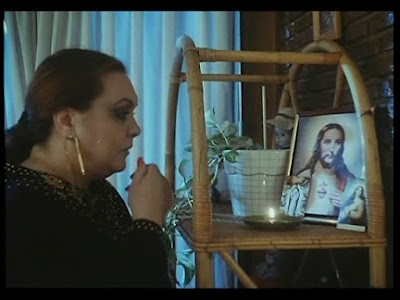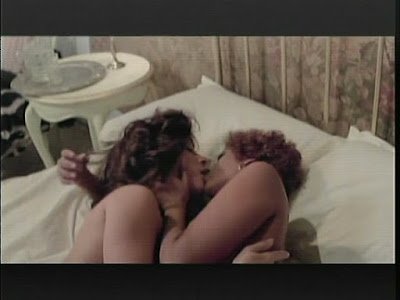El culebrero
(1998)
Here is the story of a drunk layabout, clad all in black,
who shares a special affinity with snakes.
He is being followed, as he stumbles throughout the film, by a
strikingly beautiful woman, also clad completely in black. Stiglitz plays a powerful land baron with a
wealth of affectations: cigar, glass of
tequila, faithful dog always at his side, wheelchair, and oxygen tank. Yes, Stiglitz is disabled in this one, but
his character is full of piss and vinegar.
A decent fellow lives in the shadow of Stiglitz’s hacienda with a small
farm, accompanied by his lovely wife and teenage daughter. He needs Stiglitz to cut him a break. The drunk layabout kills a few of Stiglitz’s
peeps. Then, purely by accident, the
drunk layabout witnesses the death of Stiglitz’s weed dealer by heart
attack. He brings the corpse to the
local police station, and when Stiglitz sees his dead homey next to the drunk
layabout (still clad in all black), he is certain that he is the killer. The decent fellow, who needs Stiglitz to give
him a break, is recruited by Stiglitz to kill the drunk layabout. He cannot bring himself to do it, because,
after all, he is a decent fellow and the drunk layabout is an okay guy. So, Stiglitz has his henchman kidnap the
decent fellow’s wife and daughter to force him to kill the drunk layabout. The two men have a showdown, but the
strikingly beautiful woman, also clad completely in black, intercedes; and the
decent fellow and the drunk layabout join forces to rescue the women and take
down Stiglitz. If this synopsis does not
make a lot of sense, then that’s cool.
El culebrero is a
modern-day Western with some odd themes thrown in. In a signature shot, the drunk layabout gets
ambushed by some of Stiglitz’s hitmen.
He feigns death, and as the hitman search his horse basket, they find a
bundle of snakes. One of the hitmen
kills the snakes with his automatic rifle.
The drunk layabout loses his shit, subdues a nearby hitman, grabs his
weapon, and kills the entire group of assailants. The drunk layabout keeps a snake inside of
his shirt, like a pet, and at opportune times, he pulls snakes from his pockets
and wields them like weapons. The
strikingly beautiful women, also clad completely in black, appears almost in a
supernatural role, like the guardian angel of the drunk layabout. Stiglitz yells at people; drinks tequila,
smokes cigars; and sucks oxygen from his tank.
El culebrero is definitely
weird, yet it is nothing special for Stiglitz fans.
La noche de la bestia
(1988)
Stiglitz and four of his homies go to a secluded shack for a
hunting party. On the first day, there
is male bonding, hunting, drinking, more drinking, and more male bonding. On the second day, after a morning of
hunting, Stiglitz and his homies see a beautiful woman running on the shore of
the lake, with armed pursuers following in a jeep. The beautiful woman and her pursuers are all
wearing the same yellow jumpsuit. One of
Stiglitz’s homies gets shot, and the rest of his crew kill the pursuers and
rescue the woman. They bring their
injured homey inside along with the woman.
They tend to his wounds, and the woman collapses from exhaustion. Stiglitz and his homies are in possession of
an operational automobile. Do they go
the police and report this incident? No.
First, let’s back up.
During the opening shot of La noche de la bestia, the yellow-jumpsuit-ed team packs some TNT
into the side of a mountain and detonate their bomb. They remove a large clump of glowing
ore. During the second night of the
hunting party of Stiglitz and his homies, they go outside the shack when they
hear a loud explosion. Over the horizon,
with state-of-the-art special effects, they witness a nuclear explosion. They chalk it off to the doings of the
locals. The following day the shootout
occurs. Stiglitz stays with his injured
homey, the beautiful woman, and another homey in the shack. The other two homies take the vehicle and drive
towards the explosion. They encounter a
shack where yellow jumpsuit-ed body parts and torn limbs are strewn about. They take the computer from the shack and
return to the hunting party. The dude that gets shot stumbles outside to get a
bottle of whiskey from the vehicle. He
goes missing, as something comes rising out of the lake to munch upon him. Stiglitz stays with the beautiful woman, as
the remaining bunch go looking for their injured homey. The beautiful woman, now conscious, requests
a shower. She comes out of the bathroom
and seduces Stiglitz. They do the
nasty. When the remaining hunting party
returns, they find the woman dead and Stiglitz possessed. Stiglitz tries to kill his homies, but they
put him down. They have an encounter,
then, with a monster.
I am not a big fan of male bonding and drinking, especially
with the inclusion of firearms; so the first have of La noche, is fairly pedestrian.
Its highlight is a scene evocative of the “dueling banjoes” sequence
from Deliverance (1972). La
noche really starts cooking when the group encounter the beautiful woman
running along the shore of the lake.
Then, La noche adopts the
skeleton narrative of John Carpenter’s The
Thing (1982) and becomes a decent, B-movie, sci-fi/horror film. It is worth noting that the DVD version of La noche de la bestia that I watched
appeared censored: the audio would drop
out periodically (presumably to remove profanity); the shower scene of gorgeous
Lina Santos appears abbreviated; and the pivotal scene of Stiglitz and Santos
doing the nasty is absent (it is rare that a B-movie would have its viewer
infer an important plot point and avoid sensationalism.) However, as food for thought, La noche de la bestia is very violent
with its violent scenes seemingly intact.
This one turns out pretty cool and an addition to the syllabus for the
serious Stiglitz student.
Traficando con la
muerte (2001)
The first half of Traficando
con la muerte, you can file under “fuck yeah!” Stiglitz plays a drug-addicted, seriously disturbed
individual who practices voodoo; worships the devil; and kills people. He looks like a hooded corpse. In the opening scene, Stiglitz snorts some
coke and says some mumbo jumbo in his dilapidated shack. He goes outside and hooks up with two chumps. They climb aboard a big rig and hit the road
(they are trafficking drugs). The police
set up a roadblock, but Stiglitz tells his chumps to drive through it. Stiglitz and the chumps disembark from the
semi and engage in a firefight with the police.
Stiglitz shoots the lead police officer and spares his life, only after
giving him a grimacing smile. They are
the only two to survive. Subsequent to
this shootout, the surviving police officer begins to have hallucinations of
Stiglitz. Is it Stiglitz voodoo or
PTSD? I do not know, but the police
officer is forced into medical leave until he is better. Stiglitz attends a rodeo, and after a fight
with her boyfriend, a very beautiful woman gets seduced by Stiglitz’s mumbo
jumbo. He takes her back to her home,
and the two do the nasty. The woman’s
boyfriend shows and catches the two in bed.
Stiglitz ices the man and sweetly kisses the woman goodbye. The local drug dealer needs some more drug
trafficking via big-rig trucks, so he sends two chumps to Stiglitz’s
shack. One of the two is rather plump,
so Stiglitz disembowels the man, so the narcotics can be fit inside. They cross the border with a coffin in the
back of the big-rig truck. The police
quickly allow them to pass. At this
point in Traficando, Stiglitz has
pissed off quite a few people who come gunning for him. Stiglitz finds a homey, drinks tequila, and
snorts cocaine. The final shootout is
eminent.
In Traficando,
Stiglitz plays a truly evil character whose services are for purchase. (“Dirty deeds done dirt cheap,” as the saying
goes.) The second half of the film
forces its story into a traditional action film which offsets the coolness of
the first half. I really preferred just
watching scary Stiglitz go around performing evil acts without purpose. The first half is essential exploitation
cinema, and overall, Traficando con la
muerte is well-worth seeing for the Stiglitz fan.






































